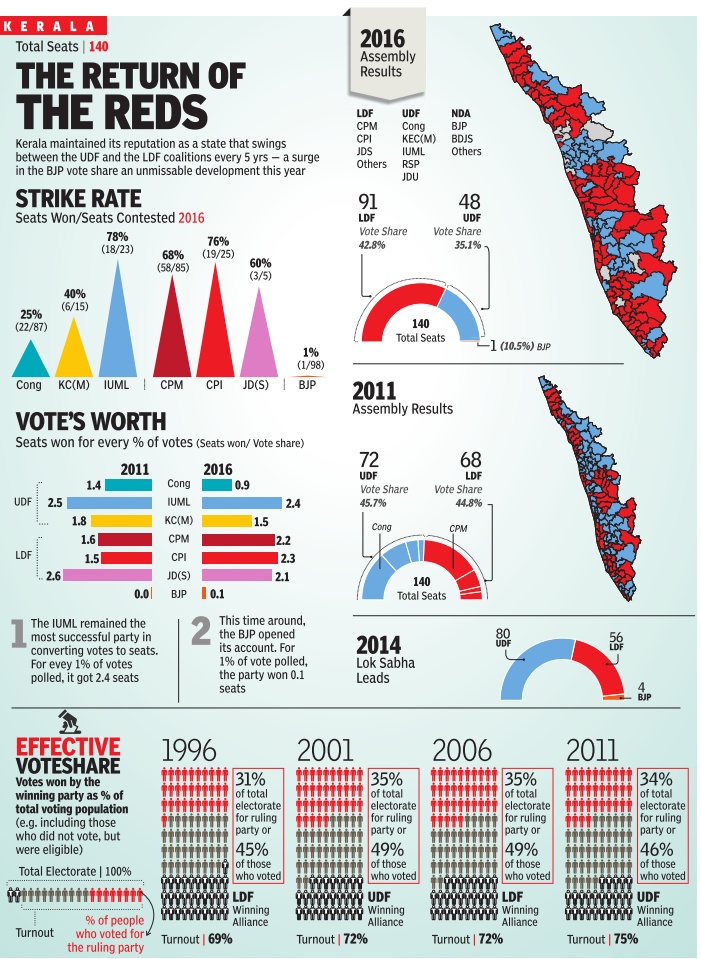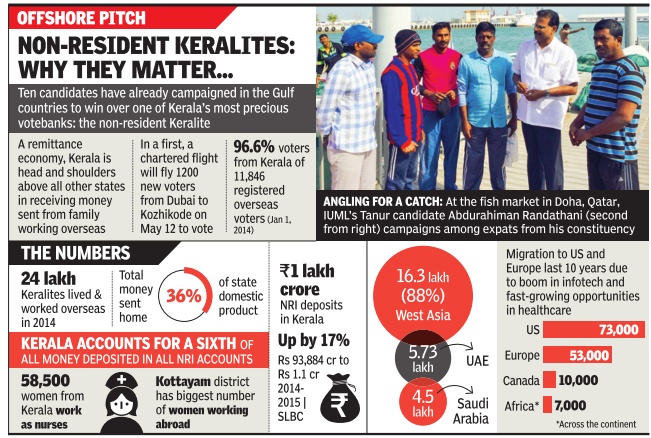Kerala: Assembly elections
This is a collection of articles archived for the excellence of their content. |



The 2016 verdict vs. 2011
The Times of India, May 20 2016
Kerala's historic verdict ensured continuity of its patent ed bipolar politics by showing scam-ridden United Democratic Front (UDF) the door and giving an impressive mandate to CPM-led Left Democratic Front (LDF), but simultaneously signalled radical change by providing BJP a beachhead and ending decades of electoral untouchability .
The LDF won 91seats with a vote share of 42.6% , a fall by almost 3% from 2011, while the UDF had to be content with 47 seats and a vote share of 38.18%, a slide of almost 7%. The BJP managed to win just one seat, at Nemom in the capital district, where veteran O Rajagopal won by a convincing margin of 8,671votes.
Though none of the NDA partners fared well individually, BJP's candidates came a close second in seven seats and decided the outcome in as many as 30. Most crucially , they nearly tripled their vote share from 6% (when they contested as a single party) in 2011 to 15.5% (as part of the NDA) in 2016.
The LDF was ecstatic following the results with CPM veteran V S Achuthanandan, a CM aspirant, interpreting it as “a verdict against the UDF government, which blindly followed the `anti-people' policies of the Narendra Modi government at the Centre. It is also a verdict against a government which failed to give protection to the women in the state“.
The LDF's victory has been a virtual repeat of 2006 but the comparison ends there, because this time it was not just anti-incumbency .
The rise of the BJP-led NDA played a significant role in the extent of the LDF win. This consolidation was evident in the gains that the LDF made in the erstwhile Malabar districts like Malappuram, Kozhikode and Kannur, where the Muslims have a substantial presence.
Interestingly , the LDF benefitted from the NDA's looming presence indirectly too, with most of the Ezhava votes corralled by the BJP's main ally BDJS, cutting into UDF's support base. The LDF sweep in Kollam and Thrissur districts -winning all 11 seats in the former, and 12 of 13 in the latter -appeared to confirm this.
The NDA's performance also seemed to underscore the fact that while the BDJS and sundry smaller parties did definitely bring in votes, it was BJP's cachet of a national party , and especially one on the ascendant across India, that was the true allure for hitherto uncommitted voters.
The UDF had banked on its controversial new liquor policy that aimed at phased prohibition as a sure-shot votepuller, particularly among women and the Christians, and it was one legacy that the Oommen Chandy government hoped would compensate for all its misdemeanours. But apparently it had hoped too much. Excise minister K Babu, Chandy's main lieutenant and one of the main faces of the bar bribery scam, lost in Thripunithura by 4,467 votes, a constituency considered his fief.
Similar voter ambiguity was reflected on the issue of `corruption'. But former finance minister K M Mani, the target of LDF ire for his alleged money-making penchant, suffered some anxious moments but finally coasted through from Pala.
In the end, if it was a hardearned victory for the LDF, it was an emotionally more momentous one for the BJP. As Rajagopal put it, “Everyone, including CPM and Congress, was saying that BJP will not open its account in Kerala... A K Antony ridiculed us by saying that the only way BJP can enter the assembly is by taking a visitor's pass.“